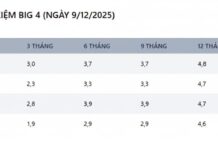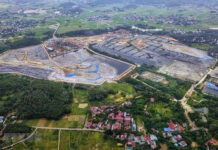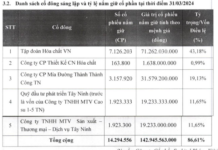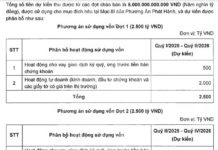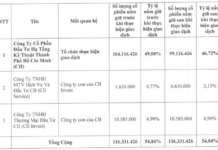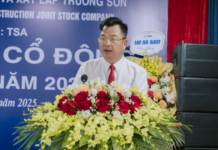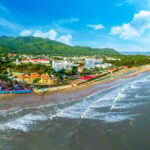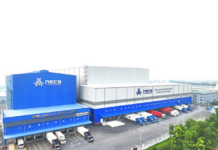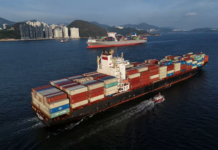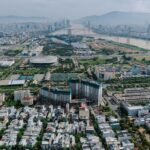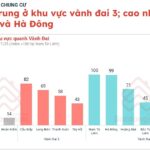Suggestions for Government Support for Renewable Energy Projects
Ha Sy Dong, Vice Chairman of the People’s Committee of Quang Tri province, stated that they have proposed to the Prime Minister several important solutions to remove obstacles for renewable energy projects.
Thus far, the total installed capacity of renewable energy projects in the province that have been put into commercial operation is 1,119.5MW.
Regarding renewable energy projects already included in the Power Development Plan VII and its adjustment, which are currently under investment in the province: There are currently 11 wind power projects with a total capacity of 424MW and seven small hydropower projects with a total capacity of 93MW under development. One of these, the Huong Linh 4 Wind Power Plant, has completed installation but is awaiting permission from authorized agencies to conduct testing and supervision procedures for grid connection to the national power system for official operation. Additionally, some projects are facing delays due to issues with grid connection extensions and specialized agreements with the power sector, resulting in slow progress and a waste of social resources.

Therefore, the Vice Chairman proposed that the Prime Minister direct relevant ministries and sectors to address these issues to put these projects into operation soon. Additionally, based on the province’s practical situation, he suggested considering allocating an additional 1,500 – 2,000MW of onshore wind power capacity and 2,600 – 4,000MW of offshore wind power capacity to Quang Tri province.
Furthermore, the Vice Chairman also proposed to the Prime Minister regarding the early approval of the Plan for implementing the Power Development Plan VIII and the conversion of the coal-fired power plant project to an LNG-fired power plant.
Earlier, at the regular Government meeting for December 2024 on December 7, 2024, the Government voted to pass a resolution on the orientation, direction, and solutions to remove obstacles and difficulties for renewable energy projects, including addressing violations and problems and providing principles, solutions, and authority for resolution.
With the orientation to become the energy center of Central Vietnam by 2030, Quang Tri province has just proposed to the Ministry of Industry and Trade to add an additional 4,100 – 6,000MW of onshore and offshore wind power capacity to the Power Development Plan VIII.
Adding 6,000MW of Power to the Master Plan
Quang Tri aims to become the energy center of Central Vietnam by 2030, in line with the Government’s support and the resolution of the 17th Provincial Party Congress.
To date, the total commercial electricity output of energy projects in the province is 1,119.5MW, and it is expected that in 2024, an additional 30MW wind power project will be put into commercial operation.

Several other wind and hydropower projects with a total capacity of 487MW are under development, along with LNG-fired power projects with a capacity of 1,500MW, natural gas-fired power projects with a capacity of 340MW, and a proposed conversion of a coal-fired power project to LNG with a capacity of 1,500MW.
Vietnam Electricity (EVN) is also constructing several 500kV transformer substation and transmission line projects in Quang Tri. The operation of these transmission grid projects will enhance power transmission capacity and provide a basis and criteria for Quang Tri province to develop the potential of wind power projects in the western and offshore areas.
According to the Power Development Plan VIII, Quang Tri province is allocated a total capacity of 1,800MW by 2030. Excluding the projects already in operation, the province commits to selecting investors for the remaining allocated capacity of 632.6MW.
However, there are currently 62 onshore wind power projects with a total capacity of about 4,748MW that have been studied, surveyed, and proposed, and they are included in the list of potential projects of the Power Development Plan VIII.
Therefore, the People’s Committee of Quang Tri province proposed that the Ministry of Industry and Trade consider increasing the onshore wind power capacity for the province by an additional 1,500 – 2,000MW.
According to local leaders, for offshore wind power in the Con Co island area, there are currently three offshore wind power projects with a total capacity of 2,600MW included in the list of potential projects of the Power Development Plan VIII, and four projects with a total capacity of 3,000MW have been approved by the Provincial People’s Committee for survey and research. As a result, Quang Tri proposed that the Ministry of Industry and Trade consider allocating offshore wind power sources to Quang Tri with a capacity of 2,600 – 4,000MW. The total capacity that Quang Tri proposed to add to the Power Development Plan VIII this time is 4,100 – 6,000MW of onshore and offshore wind power.
“Eximbank Empowers MSMEs to Overcome Growth Pains and Soar to New Heights”
“In an effort to support small and medium-sized enterprises (SMEs) in adapting to new trends, the government and banks have introduced a plethora of incentives and supportive policies. These initiatives aim to enhance the competitiveness and foster the sustainable growth of these businesses.”
Disrupt No More: Overcoming Production Pitfalls and Labor Shortages
To combat pollution and create a more aesthetically pleasing urban landscape, the provinces of Binh Duong and Dong Nai are implementing a plan to relocate factories and manufacturing workshops to designated industrial clusters and parks. This relocation initiative has sparked concerns among businesses about potential disruptions to their operations and a possible labor shortage as workers may be reluctant to commute longer distances.







